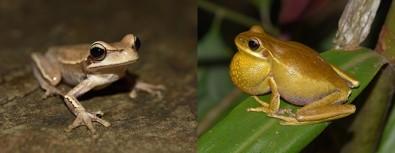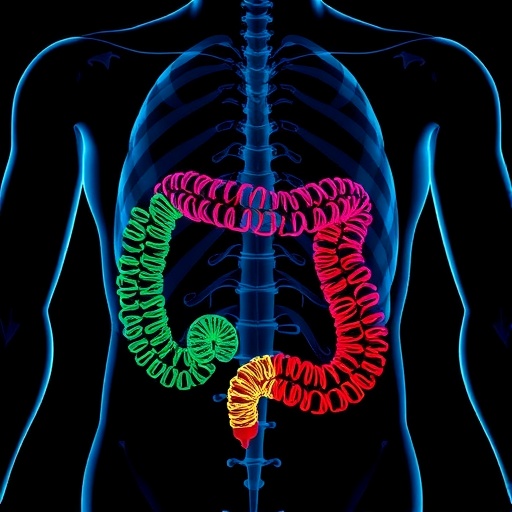The role played by symbiotic microorganisms isolated from the skin of anurans has been discovered by researchers in Brazil. The study is published in Proceedings of the National Academy of Sciences.

Credit: Andrés Brunetti
Brazilian scientists have discovered that the strong odor released by some amphibian species is produced by bacteria and that attracting a mate is one of its purposes.
The bacteria in question are a noteworthy example of symbiosis as they assist in the animal’s mating process. A paper recounting the discovery of this role of microorganisms isolated from the skin of frogs has been published
in the journal Proceedings of the National Academy of Sciences (PNAS).
“Frogs emit a pungent odor. Sometimes a particular species can be recognized by its scent, but until now, the function of this odor was unknown. It was typically assumed to be an aposematic smell, meaning a chemical warning sign that served to repel predators, as in the case of skunks [Mephitis mephitis] among mammals, for example,” said Célio Haddad, a professor at São Paulo State University’s Rio Claro Bioscience Institute (IBRC-UNESP) in Brazil and a coauthor of the article.
According to Haddad, who is also affiliated with the university’s Aquaculture Center (CAUNESP) in Jaboticabal, this hypothesis was considered plausible because many amphibian species, especially when poisonous, are brightly colored, and this serves as a visual alert to frighten predators. “We thought odor might play a similar role among anurans [frogs and toads],” he said.
The new study resulted from the postdoctoral research of Argentinean biologist Andrés Eduardo Brunetti, supervised by Professor Norberto Peporine Lopes. Conducted at the University of São Paulo’s Ribeirão Preto School of Pharmaceutical Sciences (FCFRP-USP), the research was supported by São Paulo Research Foundation – FAPESP.
“The importance and originality of Brunetti’s research is that for the first time it shows a pronounced difference in the odors emitted by frogs of opposite sexes,” Haddad said. “No other studies of anurans have ever described this type of behavior. The results suggest that the odor serves to permit mutual recognition between males and females of the same species for mating purposes.”
The research was also supported by the FAPESP Research Program on Biodiversity Characterization, Conservation, Restoration and Sustainable Use (BIOTA-FAPESP) and by the University of São Paulo (USP), the National Council for Scientific and Technological Development (CNPq) and Brazil’s Coordination for the Improvement of Higher Education Personnel (CAPES).
“In anurans, you often see different species sharing a lake or marsh. In such places, there are 30 male frogs for every female of the same species on average. The question is how the females recognize males of their own species among a multitude of males belonging to several species while they’re all vocalizing at the same time,” Brunetti said.
“It’s well-known that the function of the call of anuran males is to attract females and that every species has a characteristic song. Our findings suggest that odor appears to play a similar role, serving as an olfactory signal that enables females to recognize males of their own species.”
Biologists were also unaware of a difference in the scents of male and female frogs. Brunetti discovered this difference during his research, whose primary goal was to understand the chemical composition of the volatile components emitted by the skin of various frog species.
His working hypothesis suggested that smell was a chemical warning sign that served to repel predators. To verify the hypothesis, Brunetti conducted field surveys at several sites in São Paulo state and Rio de Janeiro state, collecting specimens of the tree frog Boana prasina.
“It’s very hard to collect females in the wild. Initially, we managed to collect only males. When we noticed what appeared to be a sexual difference in their odors, I went into the field again with the specific aim of capturing females for comparison,” he said.
“During my doctoral research at the Argentinian Natural Science Museum in Buenos Aires, while investigating the volatile compounds in two other frog species, I discovered that the secretions were made up of a blend of 35 to 42 compounds in nine different chemical classes. We then realized that some of the compounds had the specific signature of compounds produced by bacteria.”
Brunetti came to Brazil to investigate whether the selected tree frogs had skin bacteria that produced the characteristic odor of each species, and if so, which compounds they produced. His laboratory research proceeded on two fronts: analysis of the volatile compounds released by the skin of these frogs and identification of the bacteria on their skin.
Brunetti and colleagues used gas chromatography and mass spectrometry to analyze the diversity of the volatile components secreted by the skin of B. prasina. They found that adult males and females secrete a blend of 60-80 compounds, including alcohols, aldehydes, alkenes, ethers, ketones, methoxypyrazines, terpenes and thioethers.
The compounds were exactly the same in both males and females, but the researchers were surprised to find a pronounced sexual difference in the levels of methoxypyrazines, terpenes, and thioethers.
“These three components were responsible for the difference between males and females. Thioethers and methoxypyrazines are typically produced by microorganisms,” Brunetti said.
They decided to determine whether microorganisms were the source of these compounds in B. prasina. To do so, they isolated, cultivated and identified bacteria associated with the skin of these frogs and analyzed their volatile components.
No fewer than 128 different components were detected. Analysis of each component revealed that four methoxypyrazines present in males and females were produced by a single bacterium of the genus Pseudomonas.
In B. prasina, Brunetti discovered, methoxypyrazines were much more abundant in females than in males. Two of the four types of methoxypyrazines were measured at higher levels in females, while two were found at higher levels in males.
Symbiotic relationship
“The interesting thing about Pseudomonas sp. is that these bacteria live on the skin of males and females, where they metabolize the same volatile compounds but at different levels of concentration according to the sex of the host,” Brunetti said.
The levels of methoxypyrazine measured in these frogs, he added, suggest the existence of a complex mechanism of metabolic interactions that creates a different environment on the skin of males and females, favoring the synthesis of characteristic methoxypyrazines in each sex.
“These frogs and bacteria have a symbiotic relationship. In exchange for the service provided by the bacteria, entailing sexual differentiation by scent, the frogs provide an environment – their own skin – on which the bacteria can proliferate,” he explained.
The function of this sexual difference in methoxypyrazine levels is unknown. “However, we assume that the difference in scent helps male frogs of this species recognize females of the same species in places inhabited by other frog species,” Brunetti said.
“We know that many anurans use visual communication [bright skin colors] to repel predators as well as acoustic communication [vocalization] to attract female mates. Perhaps B. prasina uses a form of olfactory communication for the same purpose.
Brunetti will attempt to confirm this hypothesis in future research. If correct, it will have major repercussions. “Only one anuran, in Madagascar, is currently known to communicate by odor. Among amphibians, salamanders, which are distant relatives of anurans, are known to use this form of communication,” Haddad said.
“If B. prasina uses scent as a form of communication, it may well be the case that other species also use olfactory communication, given that each species has a characteristic odor. Brunetti’s discovery, if confirmed, opens up a new field of investigation in herpetology, which will now focus on olfactory communication among anurans, rather than just visual and acoustic communication.”
About São Paulo Research Foundation (FAPESP)
The São Paulo Research Foundation (FAPESP) is a public institution with the mission of supporting scientific research in all fields of knowledge by awarding scholarships, fellowships and grants to investigators linked with higher education and research institutions in the State of São Paulo, Brazil. FAPESP is aware that the very best research can only be done by working with the best researchers internationally. Therefore, it has established partnerships with funding agencies, higher education, private companies, and research organizations in other countries known for the quality of their research and has been encouraging scientists funded by its grants to further develop their international collaboration. You can learn more about FAPESP at http://www.
Media Contact
Joao Carlos Silva
[email protected]
Original Source
http://agencia.
Related Journal Article
http://dx.




